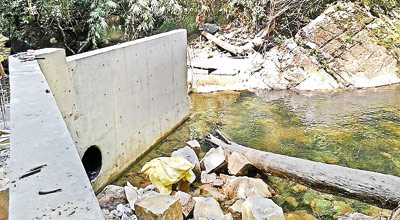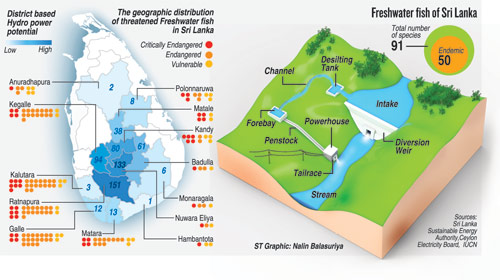News
Mini hydros: Clean energy comes at high cost to Nature

Dam being built across the Anda dola. Pic courtesy Rainforest
Mini hydro plants, touted as clean energy power sources, are destroying eco-systems in some areas, experts warned.
In Sri Lanka, large hydro power potential has all been fully utilised and what remains are opportunities for small or mini hydro power. These smaller plants are blocking streams, threatening freshwater fish and the fragile ecosystem in these water sources, a conference heard last week.
The Dams, Rivers and Freshwater Fish in Sri Lanka conference was organised by the Centre for Environmental Justice (CEJ) to focus particularly on threats to Athwelthota feared from a proposed mini-hydro power plant.
Athwelthota is a paradise for freshwater fish, with a number of species discovered in this unique habitat. The CEJ and the Wildlife Conservation Society of Galle (WCSG) have published a poster showing the indigenous fish that could be endangered by the proposed mini-hydro project in Pilithudu ella, Morapitiya-Athwelthota.
A mini hydro project works by having water in a river diverted to a powerhouse by means of a dam built across the flow. This water rotates a turbine and flows back downstream.
Not all the water can be diverted: a part has to be let flow naturally in the river, according to law.
But the change in flow is a death sentence for many species living in this micro-habitat, said Samantha Gunasekera, an expert on freshwater fish and orchids who until recently headed the Customs Biodiversity Unit.
“Different fish need different micro-habitats,” Mr. Gunasekera said. “For example, the gal padiya or sucker fish lives deep in fast-flowing water; some fish species live in relatively calm water while others prefer fast-flowing water.
But if part of a stream is diverted the habitat downstream changes and fish will be affected even though a percentage of water might be allowed to flow freely. With flow changes the PH value [acid levels] of water too could change and very sensitive species could become affected.”
“Some fish migrate upstream to breed and when the stream is blocked this movement is disrupted,” WCSG member Madhura de Silva said.
In Athwelthota, 39 freshwater species have been recorded, 20 of them endemic to Sri Lanka.
Most of the mini-hydro projects are being constructed in the biodiversity rich wet zone, so the damage they cause is actually worse than with the large dams, Mr. de Silva said. “Not only the fish but other animals such as amphibians and freshwater crabs too are affected.”

Athwelthota is also home to Sri Lanka’s only aquatic orchid. Near a waterfall lies a special “spray zone” full of water vapour and this special habitat could be totally lost, Mr. Gunasekera fears.
He emphasised the importance of considering the collective effect of all the mini-hydro power plants on a stream or a river when carrying out environmental assessment.
Many streams have been marked as potential for building mini-hydro projects and already about 37 are in construction or evaluation phase, revealed CEJ member Hemantha Withanage.
Environmentalists revealed the damage caused by a number of these projects, among them the mini-hydro plant being built crossing the Anda dola in Dellawa forest close to Sinharaja rainforest and a plant at Koskulana in the northern Sinharaja buffer zone.
The Rainforest Protectors of Sri Lanka says these projects will damage the Sinharaja World Heritage Rainforest complex.
Construction is being carried out in the Northern Sinharaja Rainforest buffer zone at Kosgulana, approximately 4km east from the Kudawa main entrance.
A dam is being built blocking the Kosgulana river in Sinharaja buffer zone and several acres of rainforest have been cleared and concrete laid along the once pristine and protected riverbank.
Large trucks and machinery used for construction have driven a wide track through what was once a small footpath in the Sinharaja buffer zone, between Kudawa and Kosgulana, the Rainforest Protectors say.
Anda Dola, a tributary of the Gin Ganga in the Neluwa Divisional Secretariat in Galle district, is the latest victim of the rapidly multiplying mini-hydro projects throughout the wet zone.
The weir and a 2.5 km section of penstock (concrete channel) has been constructed within the Dellawa rainforest, which is ecologically part of the Sinharaja Rainforest Complex.
Due to construction happening within the protected forest reserve and negligence in part by the developer, the project is said to be causing massive environmental destruction affecting the stream, rainforest, soil and endemic fish in the region.
The mini-hydro project will destroy a total 6.5 km stretch of the Anda Dola as water is being diverted from the weir to the powerhouse, several kilometres away. This will result in the local extinction of many endemic and endangered fish species recorded in the Anda Dola.
Environmental lawyer Jagath Gunawardene said project in such an environmentally sensitive area needs to undergo proper environmental assessment.
The Central Environment Authority (CEA) bears a significant responsibility to make sure Environmental Impact Assessments are being conducted thoroughly and to make certain the recommendations of the EIAs are being implemented.
CEA chairman Professor Lal Dharmaratne said his institute would take action against those who violate the law.

